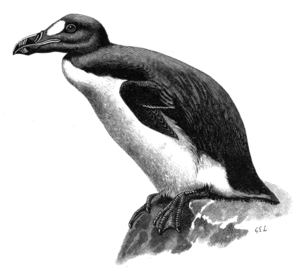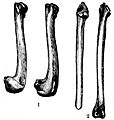Great auk facts for kids
Quick facts for kids The great auk |
|
|---|---|
 |
|
| Great auk by GE Lodge | |
| Conservation status | |
| Scientific classification | |
| Kingdom: | |
| Class: | |
| Order: | |
| Family: | |
| Genus: |
Pinguinus
Bonnaterre, 1791
|
| Binomial name | |
| Pinguinus impennis |
|
The great auk was a very large bird that lived in the Atlantic Ocean. Sadly, it could not fly. People hunted these birds for their meat and soft feathers. Because they were easy to catch and couldn't have babies fast enough, great auks became very rare. The last two great auks known were killed on June 3, 1844, in Iceland. This amazing bird spent most of its life in the water, much like a duck.
Contents
What Was the Great Auk?
The great auk was a big bird, about 75 centimeters (30 inches) tall. It had shiny black feathers on its back and head. Its chest and belly were covered in white feathers. The great auk had very short wings, almost like little stubs. This meant it could not fly at all.
These birds were excellent swimmers and divers. They used their strong, short wings to "fly" underwater, chasing fish. On land, they stood upright, waddling around.
Where Did They Live?
Great auks spent most of their time out at sea. They only came to land during the summer to have their babies. They lived in big groups called colonies on low, rocky islands. These islands were found in the northern Atlantic Ocean. Their homes stretched from Canada all the way to Norway.
Female great auks would lay just one egg directly on the bare rock. They didn't build nests. In winter, these birds would travel south. Some went as far as Florida and southern Spain to find warmer waters.
How Did Penguins Get Their Name?
You might be surprised to learn that Penguins got their name from the great auk! The word "penguin" actually came from an old Celtic word. This word was used to describe the great auk.
When sailors first saw penguins in the Southern Hemisphere, they thought these new birds looked a lot like the great auks they knew from the North. So, they called them "penguins" too.
Why Did They Disappear?
The great auk became extinct, meaning it completely disappeared from Earth. This happened mainly because of people hunting them. They were easy to catch because they couldn't fly away. Also, they only laid one egg at a time. This meant they couldn't have enough babies to replace the ones that were hunted.
The last known great auks were killed on June 3, 1844, on an island called Eldey, near Iceland. This sad event marked the end of the species.
Great Auks in Books
The great auk is a famous extinct bird, much like the Dodo. It often appears in children's literature.
- In Charles Kingsley's book The Water-Babies, A Fairy Tale for a Land Baby, a great auk tells the story of how its species died out.
- Enid Blyton's book The Island of Adventure also talks about the great auk's extinction. The main character goes on a search for what he thinks is a hidden group of these birds.
Images for kids
-
The "Great Auk, Northern Penguin, or Gair-Fowl", wood engraving by Thomas Bewick in A History of British Birds, 1804
-
Paintings showing variation in egg markings, as well as seasonal and ontogenic differences in plumage
-
Stac an Armin, St. Kilda, Scotland, one locality where the great auk used to breed
-
Great Auks by John James Audubon, from The Birds of America (1827–1838)
-
Great auk eating a fish, by John Gould
-
The only known illustration of a great auk drawn from life, Ole Worm's pet, received from the Faroe Islands, 1655
See also
 In Spanish: Alca gigante para niños
In Spanish: Alca gigante para niños
















